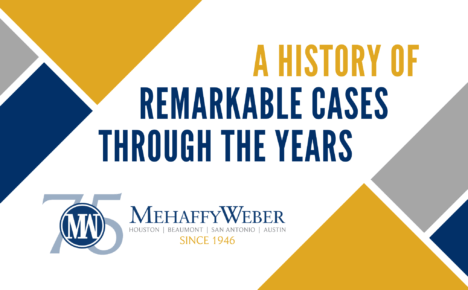
MehaffyWeber in its 75-year history has been lead counsel in many cases that have helped define Texas and national jurisprudence. MehaffyWeber was the trial counsel in the seminal case of Employers Casualty Co. v. Tilley, 496 S.W.2d 552 (Tex. 1973). Tilley was the first case to define the obligations of defense counsel that is retained by the insured. These “Tilley Duties” later became the foundation of the tripartite relationship between the insured, the insurance company, and defense counsel.
MehaffyWeber was also appellate counsel on the precedent setting cases of Union Pump Co. v. Allbritton, 898 S.W.2d 773, 775-777 (Tex.1995) and Merrell Dow Pharmaceuticals, Inc. v. Havner, 953 S.W.2d 706 (Tex. 1997). Both matters redefined causation and the bounds of acceptable expert evidence in Texas. In Allbritton, the Texas Supreme Court held for the first time that a defendant’s conduct or product must be a “substantial factor” in bringing about the plaintiff’s injuries. In Havner, the Court addressed causation and the use of epidemiology in litigation. The Court held that the plaintiff must prove the medical literature establishes a “doubling of the risk” of the alleged causal agent and also that the plaintiff was similar to those in the population studied as well as negate alternative causes. Almost 20 years later in 2007, the Texas Supreme Court relied upon the analysis of both Allbritton and Havner to require a calculable dose for asbestos claimants in its opinion in Borg Warner v. Flores, 232 S.W.3rd 765 (Tex. 2007). The Borg Warner cases altered toxic tort litigation going forward in Texas.
MehaffyWeber has also received national accolades for its trial victories. In the 1970s, the firm tried the asbestos case Borel v. Fiberboard, 493 F.2d 1076 (5th Cir. 1973) – the first asbestos case in the State of Texas and a landmark national asbestos litigation decision. Another key asbestos case was referred to as the “Five Ring Circus” because five cases were tried to five juries at the same time. Judge Robert Parker was trying to implement offensive use of collateral estoppel, but actually proved that reasonable minds can differ.
In 2001, MehaffyWeber garnered a National Law Journal Top 10 Defense Verdict of the year for its defense verdict in E. G. Cordts, e v. E. I. du Pont de Nemours and Company, Civil Action No. 1:99-CV-008; In the United States District Court for the Eastern District of Texas, Beaumont Division. MehaffyWeber defended DuPont in an environmental case. The plaintiffs were the McFaddin heirs who claimed chemicals from a DuPont plant were flushing through their wells into the earth, thus trespassing under their land and damaging mineral rights and possibly drinking water. The evidence involved use of various computer models on both sides to place the underground plume injectate. The damage claim was in excess of $170,000,000, and the jury found no liability.
In another remarkable personal injury case, MehaffyWeber tried in 2008 Richardson v. DuPont, et al, A-06-0502-HC; In the 172nd District Court of Jefferson County, Texas. The plaintiff, represented by a leader of the Texas plaintiff’s asbestos bar, claimed personal injury as a result of asbestos exposure at a DuPont facility. The Richardson case was tried over four weeks and both sides pulled out all the stops with multiple experts, documents, and fact witnesses. The damages claims were for $48 million actual damages and $1 billion in punitive damages. The jury returned a verdict of no liability. But that is where the case became remarkable. The judge granted plaintiff’s motion for new trial. Our team, knowing of several cases pending at the Supreme Court of Texas in which a party used a writ of mandamus to appeal the granting of a new trial, decided to take that approach. Texas law did not allow an appeal of the granting of a new trial. The Supreme Court of Texas remanded the matter to the Court of Appeals for an evidentiary review of the underlying case, reversed the trial court’s Order granting a new trial, and entered a final judgment in favor of DuPont. After six years of appeals, this case was one of several cases that changed the law in Texas to allow the use of mandamus to challenge the granting of a new trial.
MehaffyWeber attorneys also have had the courage to take on cases that no one else would. In the mid-1980s, Mehaffy Weber filed suit on behalf of William Hinote – a union worker – against the OCAW, a powerful labor union, and several individuals in Hinote v. Oil, Chemical and Atomic Workers Intern. Union, AFL-CIO, Local 4-23, 777 S.W.2d 134 (Tex. App. 1989). During a protracted strike, Hinote crossed the picket line and was shot five times. Taking this case was an unpopular decision because this was a time of high anxiety where tempers flared easily in the Golden Triangle. Prior to and after Hinote’s shooting, some Union members routinely harassed other members they thought were leaning toward going back to work during the strike. MehaffyWeber attorneys risked their lives and safety with the first Hinote case. Hinote’s claims against the Union among others were conspiracy and ratification – difficult claims to prove. Hinote lost the first case, but was granted a new trial based on jury misconduct. The case was tried the second time to a verdict for the Hinotes, including actual and exemplary damages. The judge granted a Judgment Notwithstanding the Verdict. MehaffyWeber appealed and won in the 14th Court of Appeals. The case illustrated the courage, tenacity, and trial and appellate skills of the MehaffyWeber team.
These are just a few of the cases from MehaffyWeber’s 75-year history. The firm continues to handle high stakes, precedent setting matters on behalf of its clients and is recognized as a “Go-To Law Firm” for litigation by Corporate Counsel throughout the country.
